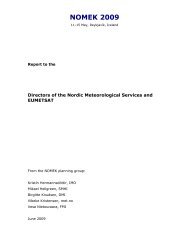International Symposium on Mitigative Measures against Snow ...
International Symposium on Mitigative Measures against Snow ...
International Symposium on Mitigative Measures against Snow ...
Create successful ePaper yourself
Turn your PDF publications into a flip-book with our unique Google optimized e-Paper software.
<str<strong>on</strong>g>Internati<strong>on</strong>al</str<strong>on</strong>g> <str<strong>on</strong>g>Symposium</str<strong>on</strong>g> <strong>on</strong> <strong>Mitigative</strong> <strong>Measures</strong> <strong>against</strong> <strong>Snow</strong> Avalanches<br />
Egilsstaðir, Iceland, March 11–14, 2008<br />
A comparis<strong>on</strong> of predicted dam heights between the traditi<strong>on</strong>al design and the design based<br />
<strong>on</strong> the shallow-layer equati<strong>on</strong>s is shown in Figure 1 for dams with a steep upstream face.<br />
From the Figure, <strong>on</strong>e notes that the shallow-layer theory results in similar heights of steep<br />
catching dams as the traditi<strong>on</strong>al theory (λ ≈ 2). In the case of deflecting dams at low<br />
deflecting angles (γ = 10°) the shallow-layer theory predicts higher dams than the traditi<strong>on</strong>al<br />
design and at large deflecting angles (γ = 30°) the dams become lower. One further notes that<br />
at low Froude numbers, the theory predicts higher dams than the traditi<strong>on</strong>al design.<br />
3. RESULTS AND DISCUSSION<br />
3.1 Braking mounds below Drangagil in Neskaupstaður<br />
Neskaupstaður is located in eastern Iceland. A large part of the residential area is threatened<br />
by avalanches from several well defined avalanche paths. A large avalanche from Drangagil<br />
reached into the current residential area in 1894. The design of avalanche defence structures<br />
for the Drangagil area was initiated in 1997 and they were built in 2002 (Sigurðss<strong>on</strong> and<br />
others, 1998).<br />
A total of 13 mounds were placed in two staggered rows in fr<strong>on</strong>t of a catching dam to reduce<br />
the speed of an avalanche which would finally be arrested by the catching dam, see Figure 2.<br />
The geometry of the mounds resembles small dams. The mounds have a steep fr<strong>on</strong>t facing the<br />
mountain, are 10 m high and each mound is approximately 10−12 m wide at the top.<br />
Figure 2 Braking mounds and catching dam in the Drangagil area in August 2002.<br />
The design avalanche had a return period of 1000 years with a 3 m thick dense core, a speed<br />
of 38 m s -1 , and thus a Froude number of 7 up<strong>on</strong> hitting the upper row of mounds. The<br />
shallow-layer theory predicts that a dam with an effective height of 32 m is needed such that a<br />
shock will form upstream of the mounds (hcr given by Equati<strong>on</strong> 2). The theory therefore<br />
predicts that the flow will be launched in a supercritical flow state over the mounds. Parts of<br />
the avalanche will be deflected between the mounds, also in a supercritical flow state. The<br />
two rows of mounds were therefore spaced such that an avalanche could be launched<br />
ballistically over the first row of mounds and would land upstream of the lower row and of<br />
the catching dam downstream of the mounds. With this design it is guaranteed that both rows<br />
of braking mounds will effectively participate in dissipating energy from the avalanche before<br />
it hits the downstream catching dam.<br />
The new design guidelines (Jóhanness<strong>on</strong> and Hák<strong>on</strong>ardóttir, 2003) also lead to a mound<br />
geometry which was quite different from the more comm<strong>on</strong> cylindrically shaped mounds.<br />
Hák<strong>on</strong>ardóttir, Tómass<strong>on</strong>, Indriðas<strong>on</strong> and Sigurðss<strong>on</strong> 81











